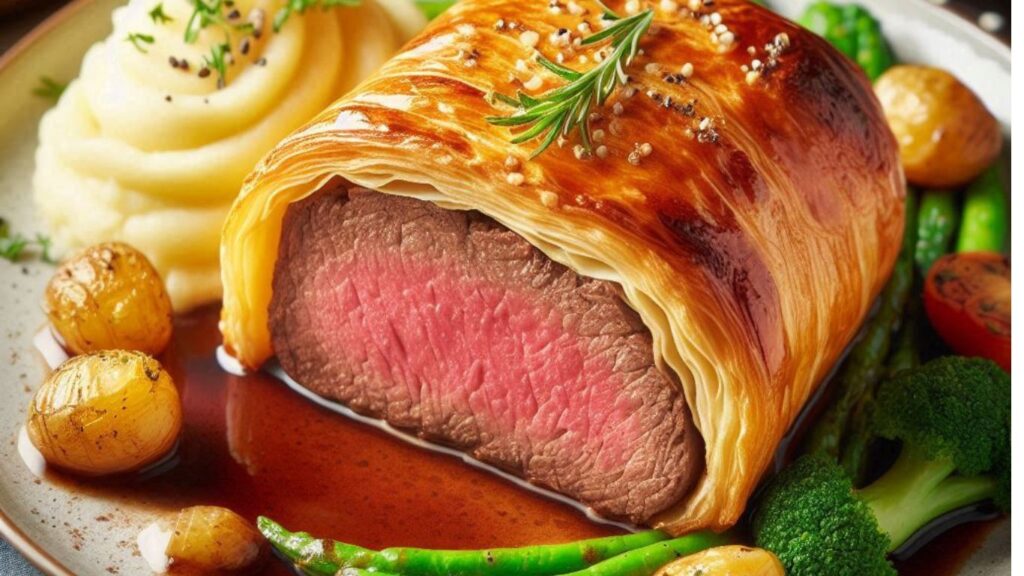We use affiliate links. If you purchase something using one of these links, we may receive compensation or commission.

Beef tenderloin, often referred to as the “king of steaks,” is a luxurious cut known for its tenderness and rich flavor. When it comes to cooking this prized meat, selecting the correct method is crucial to ensure a mouthwatering result. Let’s explore various cooking techniques and find out which one suits your taste and occasion.
Perfect Cooking Method for Beef Tenderloin
- High-Heat Roasting: Quick and Flavorful
Method: Roasting beef tenderloin at high heat is the quickest way to achieve a beautifully seared exterior and juicy interior. Here’s how to do it:
- Preheat the Oven: To prepare your oven for baking, please set the temperature to 425°F (220°C) and wait until it reaches the desired temperature.
- Prepare the Tenderloin: Place the beef tenderloin on a rack in a roasting pan. There is no need to sear it beforehand.
- Insert a Meat Thermometer: To ensure the meat is cooked correctly, use an oven-safe meat thermometer to check the temperature in the thickest part of the roast. Roast Time:
- For a 2- to 3-pound tenderloin:
- Medium-Rare (135°F): Roast for 35 to 40 minutes.
- Medium (150°F): Roast for 45 to 50 minutes.
- For a 4- to 5-pound tenderloin:
- Medium-Rare (135°F): Roast for 50 to 60 minutes.
- Medium (150°F): Roast for 60 to 70 minutes.
- Rest and Carve: Remove the tenderloin from the oven, tent it with foil, and let it rest for 15 minutes. The temperature will rise during resting.
Advantages:
- Speed: High-heat roasting is efficient.
- Crispy Exterior: Achieves a flavorful crust.
- Sear-Roasting: The Best of Both Worlds
Method: Sear-roasting combines stovetop searing with oven cooking. It’s perfect for those who crave a crusty exterior and evenly cooked interior:
- Searing: Heat a skillet on the stovetop and sear the tenderloin until browned.
- Transfer to Oven: Move the seared tenderloin to the oven.
- Use a Meat Thermometer: Cook to your desired doneness.
- Advantages:
- Texture: Achieves a beautifully crusty exterior.
- Flavor: Enhances the lean cut’s taste.
- Slow Roasting: Even Cooking from Edge to Edge
Method: Slow-roasting at a low temperature ensures even cooking throughout the tenderloin:
- Searing: Sear the tenderloin to create a flavorful crust.
- Garlic-Thyme-Butter: Slather the tenderloin with garlic-thyme-butter.
- Low Oven Temperature: Roast at 120°C (250°F) for 40 minutes.
- Advantages:
- Uniformity: Even cooking from edge to edge.
- Less Overcooked Meat: Avoids a thick band of gray, overcooked meat.
- Marinating and Roasting: Flavor Infusion
Method: Marinate the tenderloin (garlic-herb-honey marinade works well) for at least an hour. Then roast it in the oven:
- Marinate: Infuse flavors by marinating the tenderloin.
- Roast: Place it on a foil-lined baking sheet with a wire rack.
- Cook Time: Around 20 minutes for rare.
- Rest and Slice: Let it rest before slicing.
Advantages:
- Flavor: Marinating adds depth.
- Ease: Simple and effective.
Remember, the best cooking method depends on your preferences, occasion, and available time. Whether you opt for quick, high-heat roasting or slow-roasting perfection, beef tenderloin promises an indulgent dining experience. Bon appétit! 🥩🔥

